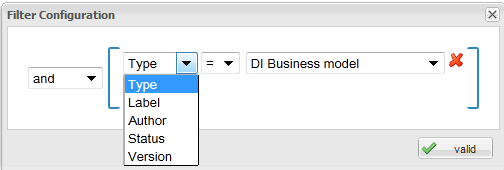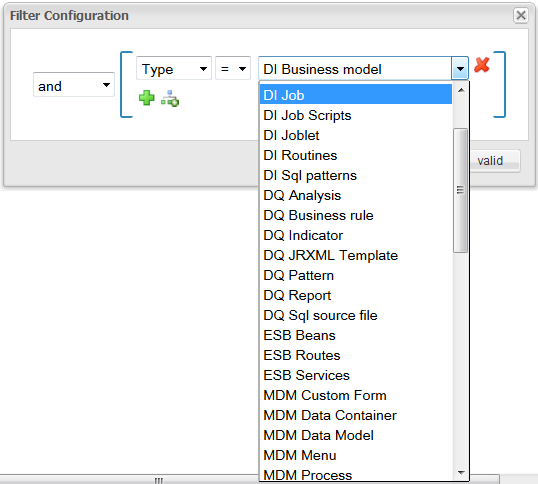How to set up a filter
Procedure
-
In the Rules page, click the
 icon next to
the Filters field.
The Filter Configuration dialog box is displayed.
icon next to
the Filters field.
The Filter Configuration dialog box is displayed. -
Select the filter nature to determine on what the filter is based.
The filter drop-down list is different depending on whether you are migrating items or generated tasks.For items, the filter is based on the Type, Label, Author, Status, or Version of the items.
Example
 For generated tasks, the filter is based on the Label, CommandLineVersion, or Status of the generated task.
For generated tasks, the filter is based on the Label, CommandLineVersion, or Status of the generated task.Example
 The table below describes the filter nature for items:
The table below describes the filter nature for items:Nature
Description
Type
Type of items available in the Repository view of Talend Studio, such as:
Business Model, Job Design, Metadata, Documentation, Context, Routines, SQL patterns, TDQ reports, TDQ analyses, MDM objects, etc.
Among them, the DQ or the MDM items are available only when you have subscribed to the 1.2.0 + version of Talend Repository Manager.
Label
Item actual name.
Author
Item author.
Status
Item statuses.
By default, this status may be:
- DEV: item development is in progress.
- TEST: item development is finalized but requires QA/test
- PROD: item can be executed or used for production.
You can read or even edit these elements from the Repository view or the Project settings view of Talend Studio. For further information, see Talend Studio User Guide.
Version
Item versions.
The table below describes the filter nature for generated tasks:Nature
Description
Label
The name of the generated task.
CommandLineVersion
The version of the command line with which the task has been generated in the Job Conductor in Talend Administration Center.
This version number is displayed in a column in the Job Conductor page starting from version 5.2.1+.
Information noteNote: You can use * when setting the command line version. For example: version%5.2_* means that all tasks where the command line version starts with 5.2_ will be migrated.Status
The status of the task displayed in the Job Conductor page in Talend Administration Center.
-
Select the operator.
Example

Operator
Description
>
Item versions greater than a given value.
This operator is available only to the Version filter.
<
Item versions lower than a given value.
This operator is available only to the Version filter.
=
Items equal to a given value.
%
Zero or more characters in an item label.
For example: label%job_* means that all jobs where label starts withjob_ will be migrated.
This operator is available only to the Label filter
-
Enter or select the expected value as the migration criterion in the text
field.
Example

-
Click the boolean button located to the left to combine filters and define
priority levels.
By default, the value is and. If you only need a single filter, leave the default setting.
- If you want to combine several filters, the two following booleans are available:
Did this page help you?
If you find any issues with this page or its content – a typo, a missing step, or a technical error – let us know how we can improve!
